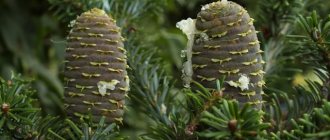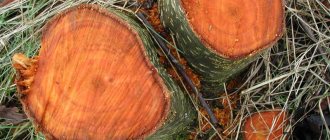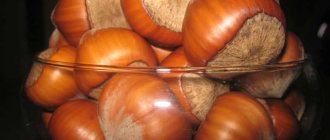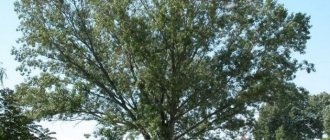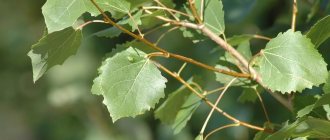Gray alder
In our forests, an inconspicuous tree, alder, is very common at first glance. It easily invades abandoned arable land and vegetable gardens and prefers damp places. People rarely look into the alder forest - good mushrooms do not grow there, and it is also not suitable for walking - nettles burn, and raspberries cling to clothes. But the strength of this tree lies elsewhere. Alder is an important medicinal plant and occupies a worthy place in the list of scientific and traditional medicine. And this is also royal firewood. But first things first.
Gray alder (Alnus incana) is a deciduous tree from the birch family (Betulaceae) up to 20 m high, or a large shrub with a rounded crown, silver-gray bark and a superficial root system.
Gray alder
The leaves are petiolate, the leaf blade is ovate or broadly elliptical, serrate. Young leaves are densely pubescent, adult leaves are pubescent only on the bottom. Flowers are unisexual. Female ones - without perianth, collected in earrings. They sit in the axils of the scales of the inflorescence, which by autumn become woody, turning into a small brown cone. Male flowers are located in the axils of the scales of long catkins. It blooms in March - April, before the leaves bloom, and is a wind-pollinated plant. So the leaves would only get in the way. The fruits ripen in August - October. And they are flat, single-seeded nuts with narrow wings. The cones, without opening, hang on the tree until spring; at the end of February-March, the seeds spill out.
Gray alder grows in forest and forest-steppe zones of the European part of Russia, in the North Caucasus, Transcaucasia, Western Siberia, and the Urals. It is found along the banks of rivers and streams, in swampy areas, along the banks of reservoirs and lakes, and quickly forms thickets on abandoned arable land, especially where groundwater is close.
One more type of medicinal raw material is allowed for use - sticky or black alder, which grows in the same areas and under the same environmental conditions, but prefers even more humid places.
Sticky alder (Alnus glutinosa) has a grayish-brown bark, rounded-obovate leaves, dark green above, dull below, sticky when young, which is why the plant got its name.
Sticky alder
downy alder (Alnus hirsuta) and Siberian alder (Alnus hirsuta var. sibirica), common in Siberia and the Far East, are also used
|
|
Description of the tree
Alder can sometimes reach fifteen meters in height, but more often it does not exceed ten meters. Young branches have sparse pubescence and are sticky. The trunk is covered with smooth gray bark. The leaves are ovoid in shape and densely pubescent on both sides.
Flowers are collected in earrings. Female flowers are short oval, usually 3-8 pieces in a group, male flowers are sessile, longer, collected in 3-5 pieces. Single-seeded nuts (fruits) are oblong cones. The tree blooms in March-April. Alder fruits ripen in autumn.
How does gray alder reproduce?
Men's and women's alder earrings.
Photo: Yandex.Pictures The flowers are very small, unisexual, collected in inflorescences-catkins. Gray alder is a monoecious plant: male and female catkins are located on the same tree.
Men's earrings have short legs, drooping, arranged in groups of three or more pieces. Female inflorescences are short, sessile, green. By autumn they turn into an oval dark brown cone.
After fertilization, female catkins become woody and turn black, and infructescences or alder cones are formed. They remain on the branches until spring. Under the scales in the axils lie fruits in the form of narrow-winged nuts. The nuts have membranous wings and are lighter than those of black alder (sticky).
The fruits of both plant species ripen in October, but the cones open only in February - March. Gray alder produces many seeds; they are dispersed by the wind, but seed propagation is not effective.
Gray alder grows very quickly; it begins to bear fruit at 8–10 years of age, and coppice individuals at 5–7 years of age. Vegetative propagation is more successful due to root suckers. The tree does not live long, only from 50 to 70 years.
Alder fruit: composition
In folk medicine today, the bark, leaves, and fruits of alder are widely used. The instructions say that the fruits contain many tannins of the pyrogall group:
- gallic acid - up to 4%;
- tannin - up to 2.5%.
In addition, they contain a lot of organic acids, glycosides, flavonoids (including the catechol group), and phytoncides.
Collection and preparation
The timing of collecting raw materials varies depending on which parts of the alder are required for medicinal purposes. The plant's cones are harvested in late autumn or early winter; annual shoots about 1.5 cm long are cut with pruning shears. It is not recommended to touch ordinary young branches; flower buds are formed on them, which are yet to bloom in the spring.
Alder catkins and pollen are harvested in the spring during the flowering period. It is better to collect the leaves of the plant before the beginning of summer, when they contain a maximum of vitamins and organic acids. Alder bark is removed before the spring growing season or in the fall shortly before cold weather, when the tree is at rest and will not suffer from damage.
Plant materials can be used immediately after collection. But more often alder is dried for long-term storage. To do this, parts of the plant are laid out in a thin layer on a flat surface in a warm room or outdoors, away from direct sun, but with good ventilation. During drying, the raw materials are stirred from time to time. You can also use electric dryers or ovens to evaporate moisture, heating them to no more than 50 °C.
Not only alder buds need drying, but also already lignified cones.
Alder should be stored in paper bags, wooden boxes or fabric bags. The place is chosen dark, moderately warm and dry, without access to sunlight. The beneficial properties of the harvesting are retained for three years, and after that a new harvest of the plant is required.
Useful properties of alder
Alder has taken its rightful place in herbal medicine, and sometimes it is not easy to find a replacement for it in the treatment of a number of diseases. Most often, alder fruits are used, although medicinal preparations are prepared based on both the leaves and bark of the plant. They have the following effects on the human body:
- anti-inflammatory;
- astringent;
- hemostatic.
Their use is recommended for:
- inflammation of the large and small intestines (enteritis, colitis);
- duodenal and stomach ulcers;
- dyspeptic disorders of the gastrointestinal tract;
- dysentery;
- articular rheumatism;
- rheumatic arthritis;
- inflammation of the respiratory system.
For men
The benefits of alder in the treatment of prostatitis are known. You will need to grind the dried tree cones into flour. They should be included in suppositories made at home for insertion into the rectum.
The basis can be pharmaceutical lanolin melted in a water bath - 200 g. Add crushed propolis - 50 g and the same amount of wax.
After intensive kneading, the homogeneous mixture is poured into an earthenware cup. Candles are formed from the cooled mass at home, placing 1/4 tsp inside. alder powder.
Keep in the refrigerator. The course lasts on average 30 days, and then a three-month break is needed. In total, you will need up to four healing courses.
Alder fruit: instructions for use
This is an effective astringent containing tannins, the basis of which is tannin and gallic acid, galactose, phosphoric acid, pentosans.
Indications for use
Tincture and infusion of fruits are recommended for chronic and acute colitis and enteritis. In the form of an infusion or decoction of alder fruit, use a tablespoon (tablespoon) three times a day. A tincture is also used, for which alder inflorescences are used. The use of this drug is limited to 25 drops no more than three times a day.
Dry extract (thmelini) is recommended to take 0.5 grams up to six times a day.
Release form
Alder fruits are produced in cardboard packaging weighing 100 grams.
Storage conditions and shelf life
Raw materials should be stored in a dry place, protected from light. The shelf life of fruits is 3 years.
Medicinal properties and contraindications
The healing properties and contraindications of alder are associated with the presence in its tissues of a large amount of tannins that have an anti-inflammatory effect. The optimal combination of tannins, quercetin and triterpene compounds normalizes the intestinal microflora, as a result of which in patients with enterocolitis, dysbacteriosis or dysentery, fermentation stops, diarrhea stops, feces become more formed, and the number of bowel movements is reduced.
Other important properties of alder preparations include:
- astringent;
- diaphoretic;
- diuretic;
- hemostatic.
There are few contraindications to the use of the plant: pregnancy, lactation, age under 12 years, individual intolerance.
The healing properties of alder are associated with the presence of tannins in it, which have an anti-inflammatory effect.
Alder inflorescences in folk medicine
Traditional healers recommend preparations based on fruits for digestive disorders, including bloating and pain. In addition, the fruit is considered an effective diaphoretic. Baths with alder cones are recommended for colds and frostbite, dermatitis and tired legs, skin ulcers and itchy rashes, scrofula and long-lasting wounds.
The decoction is effective for burns, gum inflammation, nosebleeds, pharyngitis, sore throat, allergies, and hemorrhoids. It is successfully used for douching for inflammatory diseases in women.
Application
Trees of the alder family have medicinal and healing properties. Cones from trees have anti-inflammatory and disinfectant properties, which are used to prepare various medicines. The elements contained in the leaves and bark of trees have a detrimental effect on various types of protozoan microorganisms. Therefore, parts of the tree can be used to make remedies for skin diseases - eczema, psoriasis, and various fungi.
Alder cones have also found their use in the medical field . Tinctures and decoctions of them are used in cases of colitis, dysentery, and as an astringent for stomach or intestinal bleeding. Due to their astringent properties, alder leaves and cones are used in the treatment of burns, nose and mouth bleeding, stomach ulcers, and various skin inflammations.
The healing properties of alder were known to our ancestors. Since ancient times, a decoction of alder leaves has been used as a diaphoretic for colds. It can also be used to make wonderful relaxing foot baths.
Industrial use
The use of alder for industrial purposes is quite widespread:
- although alder wood is not very durable, it is quite soft and pliable, which makes working with it for industrial purposes much easier;
- drying alder wood does not lead to the formation of cracks, and therefore this material is often used for the manufacture of musical instruments;
- has low density and soft wood, due to which wood material is widely used by artists who carry out wood carvings;
- alder products gain strength over time; wells, barrels, and underground structures are made from it;
- products made from alder wood are widely used - from decorative panels and boxes to furniture;
- The construction world of materials also widely uses alder wood - for interior decoration or furniture making.
In conclusion, it is worth noting the relatively low cost of wood, which has affected its widespread use in industry.
Infertility in cosmetology
Alder fruits are also used in cosmetology. Using them as a means of promoting hair growth, reducing hair loss and oiliness, and fighting seborrhea gives excellent results. In these cases, every day it is necessary to rub the infusion of fruits into the scalp.
Alder fruits quickly relieve skin irritation and inflammation, reduce greasiness and porosity. Many women note their tonic effect.
Where does gray alder grow?
Gray alder is a Eurasian plant with a wide range, but more often it does not extend beyond the forest zone. Gray alder usually inhabits damp forests, along the edges of swamps, the banks of rivers, lakes, and wet meadows.
In Russia, it is distributed in the forest belt of the European part, in the Urals and in the adjacent regions of Western Siberia. In the north, gray alder is distributed further than sticky alder and reaches the tundra.
Alder is a gray, moisture-loving tree species, so its growth is associated with fairly moist areas, although it can also be found in dry places, along fields, on the outskirts of hayfields.
Quickly colonizes cleared areas and abandoned arable land. In the northwestern regions it forms secondary temporary forests on the site of former spruce forests.
After gray alder, the soil becomes very fertile. Alder roots are abundantly populated by microorganisms that absorb atmospheric nitrogen, and falling leaves are rich in nitrates.
Decoction of infructescences
Pour four grams (a tablespoon) of fruits with a glass of boiling water and boil over low heat for a quarter of an hour. After this, the composition should be cooled at room temperature and filtered. Take 50 ml three times a day before meals.
According to patient reviews, a significant improvement in well-being occurs (even with chronic colitis) after just a few days of use. The decoction can be taken for dysentery, used to gargle for sore throats and other colds.
For conception
Alder has long been called the tree of conception, prosperity, and family happiness. A decoction of the bark of this tree was recommended to drink for women who dream of becoming pregnant.
The dried rhizomes of this tree also help. They are ground using a coffee grinder. Transfer 3 tbsp into a thermos. l. powder and steam it with a liter of boiling water.
Open after 10 hours and allow time to cool. Douche with the slightly warmed liquid before going to bed. After three weeks of treatment, a seven-day intermission is arranged and the procedures are repeated. It may take up to five similar cycles to obtain the predicted result.
At the same time, it is recommended to prepare a healing agent for oral administration. Take a glass of boiling water cooled to warm.
Stir in it a teaspoon of powder obtained from dry alder root and dissolve 2 tbsp. l. quality honey. Drink in small sips after waking up in the morning on an empty stomach, and also before going to bed in the evening.
Spreading
Gray and black alder grows in western Asia, almost everywhere in northern Africa and Europe. Introduced to different parts of the planet, and in North America in some places it even poses a threat to various local species. Black alder, the photo of which is presented in this article, grows in the forest, forest-steppe and steppe regions of European Russia, in addition - in Western Siberia, as well as in the Caucasus. Prefers damp lands.
Gray alder is widespread in the European region of our country. It also grows in Asia Minor, Europe, Western Siberia, and Transcaucasia. Forms plantings along the banks of small streams and rivers.
Requirements for the quality of finished raw materials
The raw material consists of mature alder cones. They are overgrown and stiff earrings that resemble cones. For the most part, they have open scales, ovoid or oval-oblong in shape with the presence of fruitlets (or without them). The infructescences should be without stems or with their remains (no more than a centimeter in length). In addition, they can be collected on a thin stem together in several pieces. They consist of a rough, hard rod, as well as numerous, hard scales. The scales should be six-lobed, and the fruits should be flattened and single-seeded. The color of the fruit is dark brown or brown. The aroma is weak, the taste is slightly astringent.
Interesting Facts
Gray alder trunk.
Photo: Yandex.Pictures Gray and black alder (sticky) and gray alder are widely used. Wood is used in the production of carpentry, plywood, matches, and paper.
The main production value of alder is determined by the presence of tannins in it.
- Alder wood quickly deteriorates in air, but lasts a long time in a humid environment. Alder trunks are used for logs of wells, for bridge piles, fastening posts in mines, and barrels. The branches are used for hedges and fences.
- It is believed that alder wood is preferable for smoking fish. They give smoked meats an attractive color and pleasant aroma.
- Coal is obtained from alder wood; previously it was used to produce gunpowder. Nowadays it is used by artists for drawing.
- Alder cones improve the water in the aquarium, reduce its acidity, and promote the spawning of aquarium fish. A ten-liter aquarium requires 3 alder cones.
- The smell of alder repels mice and mole crickets. To ensure that rodents and insects leave the area, you need to place alder branches around the fruit trees, and stick fresh alder branches around the beds.
- The leafy branches of alder are harvested as branch fodder for sheep and goats.
Alder bark is a natural dye and contains 5–9% tannins, while female cones contain 14–16% tannins. The raw material is used in a mixture with oak or willow tanning extract for tanning leather. Alder tannins color the leather dark red.
Alder raw materials are used to dye leather, wool and fabrics black, red and yellow depending on the degree of etching. In the past, in Russian villages, the bark was used to color homespun canvases.
Pickling is the preparation of a semi-finished product for dyeing. Increases hair's sensitivity to dye, changes tone and increases color fastness to light and friction.

